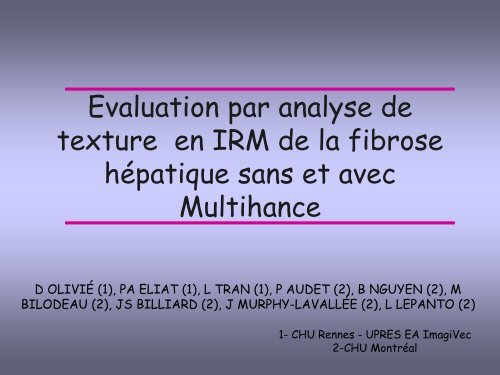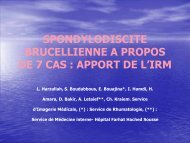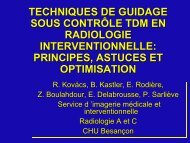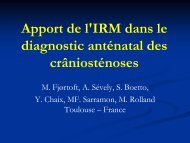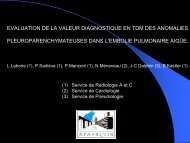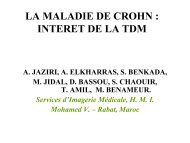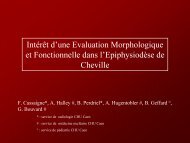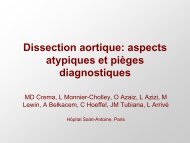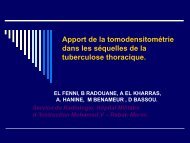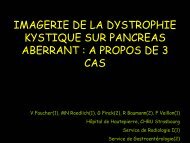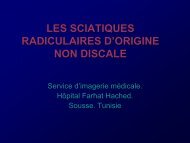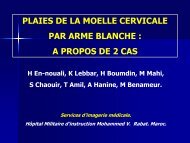Evaluation par analyse de texture en IRM de la fibrose hépatique ...
Evaluation par analyse de texture en IRM de la fibrose hépatique ...
Evaluation par analyse de texture en IRM de la fibrose hépatique ...
Create successful ePaper yourself
Turn your PDF publications into a flip-book with our unique Google optimized e-Paper software.
<strong>Evaluation</strong> <strong>par</strong> <strong>analyse</strong> <strong>de</strong><strong>texture</strong> <strong>en</strong> <strong>IRM</strong> <strong>de</strong> <strong>la</strong> <strong>fibrose</strong>hépatique sans et avecMultihanceD OLIVIÉ (1), PA ELIAT (1), L TRAN (1), P AUDET (2), B NGUYEN (2), MBILODEAU (2), JS BILLIARD (2), J MURPHY-LAVALLÉE (2), L LEPANTO (2)1- CHU R<strong>en</strong>nes - UPRES EA ImagiVec2-CHU Montréal
IntroductionL’évaluation <strong>de</strong> <strong>la</strong> <strong>fibrose</strong> est un élém<strong>en</strong>t important <strong>de</strong> <strong>la</strong>prise <strong>en</strong> charge <strong>de</strong>s hépatopathies virales, car elleconditionne <strong>en</strong> <strong>par</strong>tie les traitem<strong>en</strong>ts proposés et <strong>la</strong> prise <strong>en</strong>charge thérapeutique. Pour ce<strong>la</strong>, il existe <strong>en</strong> <strong>de</strong>hors <strong>de</strong>l’exam<strong>en</strong> invasif qu’est <strong>la</strong> ponction biopsie hépatique <strong>de</strong>smoy<strong>en</strong>s d’exploration non invasif tel que :• Quantification biologique <strong>par</strong> Fibrotest, actitest• Quantification physique <strong>par</strong> é<strong>la</strong>stographie <strong>par</strong> US voire<strong>par</strong> <strong>IRM</strong>L’évolution fibreuse peut se faire <strong>par</strong> poussée inf<strong>la</strong>mmatoireà travers les différ<strong>en</strong>ts sta<strong>de</strong>s <strong>de</strong> <strong>fibrose</strong> jusqu’à <strong>la</strong>cirrhose. L’atteinte hépatique n’est pas forcém<strong>en</strong>t <strong>de</strong>ré<strong>par</strong>tition homogène et <strong>par</strong> ailleurs l’évolution fibreuses’accompagne <strong>de</strong> changem<strong>en</strong>t <strong>de</strong> l’architecture <strong>de</strong>s espacesportes, d’une capil<strong>la</strong>risation et donc <strong>de</strong> changem<strong>en</strong>tarchitecturaux. Ces changem<strong>en</strong>ts comme <strong>la</strong> ré<strong>par</strong>titioninhomogène <strong>de</strong> <strong>la</strong> <strong>fibrose</strong> ou bi<strong>en</strong> l’ap<strong>par</strong>ition <strong>de</strong> nodules voir<strong>de</strong> macro-nodules <strong>de</strong> régénération.
IntroductionLe « Gold standard » pour évaluer l’atteinte fibreuse est <strong>la</strong> PBH.Cep<strong>en</strong>dant, La réalisation d’une PBH avec les risques <strong>de</strong>morbidité et <strong>de</strong> mortalité liés à ce geste (jusqu’à 0,57 % <strong>de</strong>complications sévères dans une étu<strong>de</strong> française réc<strong>en</strong>te [1])ainsi que les variations <strong>de</strong> ses résultats liés à l’échantillonnageet <strong>de</strong> sa lecture font discuter <strong>de</strong> son intérêt [2]. Par ailleursaucun test <strong>en</strong> <strong>de</strong>hors <strong>de</strong> l’histologie ne permet <strong>de</strong> détecteractuellem<strong>en</strong>t les faibles <strong>de</strong>grés <strong>de</strong> <strong>fibrose</strong>.Plusieurs étu<strong>de</strong>s t<strong>en</strong><strong>de</strong>nt à démontrer que l’on peut différ<strong>en</strong>cier<strong>par</strong> <strong>analyse</strong> <strong>de</strong> <strong>texture</strong> l’atteinte fibreuse notamm<strong>en</strong>t lorsqu’elleest évoluée [3-5].Une étu<strong>de</strong> réc<strong>en</strong>te mettrait <strong>en</strong> évi<strong>de</strong>nce une amélioration <strong>de</strong> <strong>la</strong>capacité à différ<strong>en</strong>cier les sta<strong>de</strong>s <strong>de</strong> <strong>fibrose</strong> avec l’adjonction<strong>de</strong> produit <strong>de</strong> contraste <strong>en</strong> <strong>par</strong>ticulier à <strong>la</strong> phase d’équilibre [6].L’utilisation <strong>de</strong> gadolinium et principalem<strong>en</strong>t du BOPTA grâce àsa spécificité hépatocytaire pourrait permettre uneamélioration <strong>de</strong>s c<strong>la</strong>ssifications notamm<strong>en</strong>t <strong>en</strong> phase d’équilibre.
Analyse <strong>de</strong> <strong>texture</strong>Principe : Analyse mathématique au sein <strong>de</strong> l’image<strong>de</strong> <strong>la</strong> ré<strong>par</strong>tition et <strong>de</strong> l’ag<strong>en</strong>cem<strong>en</strong>t <strong>de</strong>s pixels <strong>en</strong>fonction <strong>de</strong> leur niveau <strong>de</strong> gris dans une matriceprédéfinie• Plusieurs c<strong>en</strong>taines <strong>de</strong> <strong>par</strong>amètres calculés– Métho<strong>de</strong>s statistiques <strong>de</strong> premier ordre (œilhumain), métho<strong>de</strong> <strong>de</strong> l’histogramme– Métho<strong>de</strong>s d’ordres supérieurs (2 et 3) (Matrice <strong>de</strong>cooccurr<strong>en</strong>ce, <strong>de</strong>s longueurs <strong>de</strong> p<strong>la</strong>ges, métho<strong>de</strong>s<strong>de</strong>s gradi<strong>en</strong>ts, etc….)Utilisation <strong>en</strong> industrie mais aussi dans d’autresdomaines d’imagerie:• Reconnaissance automatique <strong>de</strong> <strong>texture</strong>• <strong>Evaluation</strong> <strong>de</strong>s tissus graisseux sous cutanés• CAD
Analyse <strong>de</strong> <strong>texture</strong>Imageur 1.5 T Avanto (Siem<strong>en</strong>s)Utilisation du logiciel MAZDAImage <strong>en</strong> pondération T1, T2 avant et après injection <strong>de</strong>produit <strong>de</strong> contrasteTest <strong>en</strong> imagerie 2D– Meilleur compromis résolution spatiale et contraste <strong>en</strong>1.5 T– résolution spatiale fine: moins <strong>de</strong> dilution d’information• Coupe fine• Matrice élevée• Apnée = peu <strong>de</strong> coupesChoix <strong>de</strong> séqu<strong>en</strong>ces spécifiques <strong>en</strong> pondération T2 et T1c<strong>en</strong>trées sur le hile hépatique permettant une étu<strong>de</strong> du foiedroit et du foie gauche.Réalisation <strong>de</strong>s mêmes séqu<strong>en</strong>ces 1 heure après l’injectionpour bénéficier <strong>de</strong> l’aspect hépatospécifique du MultihancePossibilité <strong>de</strong> réaliser <strong>de</strong>s calculs <strong>en</strong> acquisition 3D
Axial TSE T1 fat sat ApnéeNombres <strong>de</strong> coupes :5Fov 380mm*303mmEpaisseur 2 mmVoxel :1.6*1.5*2 mmTR : 557 ms ; TE : 7,3 msTA :14 sAxial TSE T2 fat sat ApnéeNombres <strong>de</strong> coupes :5Fov 380mm*303mmEpaisseur 2mmVoxel :1.6*1.5*2 mmTR : 2000 ms ; TE : 70msTA : 14 s
Etu<strong>de</strong>Projet réalisé conjointem<strong>en</strong>t <strong>en</strong>tre le CHU <strong>de</strong> Montréal(Hôpital St Luc), le CHU <strong>de</strong> R<strong>en</strong>nes et les équipes <strong>de</strong>traitem<strong>en</strong>t du signal <strong>de</strong> l’université <strong>de</strong> R<strong>en</strong>nes (U642 LTSIet UPRES EA 3890 Imagivec)Accord du comité d’éthique du CHUMEtu<strong>de</strong> prospective prévu pour une inclusion <strong>de</strong> 60 à 80pati<strong>en</strong>ts– Critères d’inclusions:• PBH <strong>de</strong> moins <strong>de</strong> 3 mois pour évaluation d’hépatopathie virale C• Pas <strong>de</strong> traitem<strong>en</strong>t antiviral ou anti-fibrotique avant l’<strong>IRM</strong>• Pas <strong>de</strong> contre-indication à l’<strong>IRM</strong> ou au produit <strong>de</strong> contraste• Cons<strong>en</strong>tem<strong>en</strong>t éc<strong>la</strong>iré
Popu<strong>la</strong>tionDe mai 2006 à juin 2007 21 pati<strong>en</strong>ts inclus9 femmes, 12 hommesÂge moy<strong>en</strong> : 49 ansC<strong>la</strong>ssification histologique suivant Ishak:– Sta<strong>de</strong> O=3, I=6, II=4, III=6, IV=1, V=1, VI=0C<strong>la</strong>ssification selon métavir– F0=3, F1=10, F2=7, F4=1
Analyse <strong>de</strong> <strong>texture</strong>• Analyse après définition d’une Région d’Intérêt <strong>de</strong> gran<strong>de</strong> taille<strong>en</strong> foie droit et <strong>en</strong> foie gauche excluant les gros vaisseaux etceci sur les <strong>de</strong>ux meilleures coupes <strong>de</strong> chaque sérieSélection <strong>de</strong>s <strong>par</strong>amètres les plus discriminants <strong>par</strong> :• Critère <strong>de</strong> Fisher (10 items)• POE+ACC (probability of c<strong>la</strong>ssification error and average.corre<strong>la</strong>tion coeffici<strong>en</strong>ts) (10 items)• information mutuelle (10 items• sur les 30 meilleurs issus <strong>de</strong>s 3 approchesAnalyse <strong>par</strong> PCA (Principal compon<strong>en</strong>t analysis) ou LDA (lineardiscriminant analysis)Il n’a pas été possible <strong>de</strong> réaliser <strong>de</strong> c<strong>la</strong>ssification <strong>en</strong> NDA (Nondiscriminant analysis) ou réseau <strong>de</strong> neurones car les échantillonsne sont pas assez grands pour tester les différ<strong>en</strong>tes possibilités<strong>de</strong> réseau
Analyse <strong>de</strong> <strong>texture</strong>Par type <strong>de</strong> séqu<strong>en</strong>ce:• T1 avant Gd• T1 après Gd• T2 avant Gd• T2 après Gd• Foie droit / foie gaucheTout score confondu selon <strong>la</strong> c<strong>la</strong>ssification d’IShakTout score confondu selon <strong>la</strong> c<strong>la</strong>ssification <strong>de</strong> MetavirSélection <strong>en</strong> fonction du nombre <strong>de</strong> mal c<strong>la</strong>ssés et <strong>de</strong> nonc<strong>la</strong>ssésSélection <strong>de</strong>s c<strong>la</strong>ssifications réalisant moins <strong>de</strong> 20 % <strong>de</strong> malc<strong>la</strong>ssés
Résultats% <strong>de</strong> mal c<strong>la</strong>sséDGT1 ap GDT1 av GDT2 ap GDT2 av GD30 mes Ishak30 mes Métavir30 mes Ishak30 mes Métavir30 mes Ishak30 mes Métavir30 mes Ishak30 mes Métavir4.76 2.380 09.52 09.52 2.380 00 2.38>20 >200 >20
Résultats30mes Métavir T1ap DCorrespondanceMétavir IshakF0=1 St0=1F1=2 St1=2F2=3 St2=3F4=4 St3=4St4=5St5=630mes Ishak T1av G30 mes Ishak T2av D
DiscussionLa plu<strong>par</strong>t <strong>de</strong>s c<strong>la</strong>ssifications réalisées à <strong>par</strong>tir soit d’une sélection<strong>de</strong> <strong>par</strong>amètres <strong>par</strong> test <strong>de</strong> Fisher, <strong>de</strong> POE+ACC ou <strong>par</strong> informationmutuelle n’ont pas permis d’avoir <strong>de</strong>s résultats avec moins <strong>de</strong> 20%<strong>de</strong>s échantillons mal c<strong>la</strong>ssés.Seules les c<strong>la</strong>ssifications faites <strong>en</strong> combinant les 30 <strong>par</strong>amètres lesplus discriminants issus <strong>de</strong>s 3 métho<strong>de</strong>s <strong>de</strong> sélection permett<strong>en</strong>t<strong>de</strong>s c<strong>la</strong>ssifications <strong>par</strong>faites ou presque.Seul l’<strong>analyse</strong> linéaire discriminante propose <strong>de</strong>s c<strong>la</strong>ssifications sansou avec très peu <strong>de</strong> mal c<strong>la</strong>ssés.Ce sont les séqu<strong>en</strong>ces réalisées après injection <strong>de</strong> gadolinium quic<strong>la</strong>ss<strong>en</strong>t mieux. Cet aspect vi<strong>en</strong>t d’être décrit[6]. Cet aspect sembleassez logique surtout avec du Multihance au mom<strong>en</strong>t <strong>de</strong> <strong>la</strong> phased’étu<strong>de</strong> biliaire. Par contre il est assez difficile d’expliciter cemême phénomène <strong>en</strong> pondération T2.
DiscussionIl n’y a pas <strong>de</strong> différ<strong>en</strong>ce significative <strong>en</strong>tre lesc<strong>la</strong>ssifications histologiques d’Ishak et Métavir dansl’obt<strong>en</strong>tion <strong>de</strong> meilleurs résultats.Il n’existe pas <strong>de</strong> différ<strong>en</strong>ce significative <strong>en</strong>tre les résultats<strong>en</strong> foie G et <strong>en</strong> foie DL’adjonction <strong>de</strong> produit <strong>de</strong> contraste semble améliorer lesrésultats <strong>de</strong>s c<strong>la</strong>ssifications <strong>en</strong> T1 et T2. On obti<strong>en</strong>t <strong>en</strong>effet moins <strong>de</strong> mal c<strong>la</strong>ssés 1 heure après l’injection <strong>de</strong>Mutlihance. Cet aspect serait il va<strong>la</strong>ble <strong>en</strong> cas d’<strong>analyse</strong> <strong>de</strong><strong>texture</strong> 3D <strong>de</strong>s séqu<strong>en</strong>ces 3D T1 dynamique?L’<strong>analyse</strong> <strong>de</strong> <strong>texture</strong> étant développée sur <strong>de</strong>s modèlesmathématiques et statistiques, elle nécessite d’être testersur <strong>de</strong> nombreux échantillons, ces résultats ne sont donc quepréliminaires mais sembl<strong>en</strong>t <strong>en</strong>courageants
ConclusionL’<strong>analyse</strong> <strong>de</strong> <strong>texture</strong> semble permettre <strong>la</strong> différ<strong>en</strong>ciation<strong>de</strong>s différ<strong>en</strong>ts gra<strong>de</strong>s <strong>de</strong> <strong>fibrose</strong> même <strong>en</strong>tre les faiblesgra<strong>de</strong>s.L’utilisation du Multihance améliore les résultats <strong>de</strong>sc<strong>la</strong>ssifications à un temps tardif après l’injection du produit<strong>de</strong> contraste. L’intérêt serait il le même lors <strong>de</strong>s séqu<strong>en</strong>cesdynamiques (<strong>analyse</strong> <strong>de</strong> <strong>texture</strong> 3D) ?L’augm<strong>en</strong>tation <strong>de</strong> l’effectif <strong>de</strong> l’étu<strong>de</strong> permettraprobablem<strong>en</strong>t d’affiner ces résultats, d’utiliser et <strong>de</strong> définirun ou <strong>de</strong>s réseaux <strong>de</strong> neurones pour différ<strong>en</strong>cier les sta<strong>de</strong>sfibreux.Par ailleurs le traitem<strong>en</strong>t <strong>de</strong>s données dynamiques 3D est<strong>en</strong>visagé <strong>en</strong> <strong>analyse</strong> <strong>de</strong> <strong>texture</strong> 3D <strong>de</strong> façon à essayerd’individualiser <strong>de</strong>s <strong>par</strong>amètres <strong>de</strong> <strong>texture</strong>s fonction <strong>de</strong> <strong>la</strong>perfusion hépatique.
Référ<strong>en</strong>ces[1]-Cadranel JF, Rufat P, Degos F. Practices of liver biopsy in France:results of a prospective nationwi<strong>de</strong> study. Hepatology 2000; 32: 477-481[2]-Regev A, Berho M, Jeffers LJ, Milikowski C, Molina EG, Pyrsopoulos NT,F<strong>en</strong>g ZZ, et al. Sampling error and intraobserver variation in liver biopsy inpati<strong>en</strong>ts with chronic HCV infection. Am J Gastro<strong>en</strong>terol 2002;97: 2614–2618.[3]-Jirak D, Dezortova M, Taimr P, Hajek M. Texture analysis of humanliver. J Magn Reson Imaging 2002;15:68-74[4]-Matalka II, Al-Jarrah OM, Manasrah TM. Quantitative assessm<strong>en</strong>t ofliver fibrosis: a novel automated image analysis method. Liver int2006;26(9):1054-1064[5]-Zhang X, Fujita H, Kanematsu M, Zhou X, Hare T, Kato H, Yokoyama R,Hoshi H. Improving the c<strong>la</strong>ssification of cirrhotic liver by using <strong>texture</strong>features. Conf Prec IEEI Eng Med Biol Soc 2005;1:867-870[6]-Kato H, Kanematsu M, Zhang X, Saio M, Kondo H, Goshima S, Fujita H.Computed-ai<strong>de</strong>d diagnosis of hepatic fibrosis: preliminary evaluation of MRI<strong>texture</strong> analysis using the finite differnce method and an artificial neuralnetwork. AJR 2007; 189:117-122


